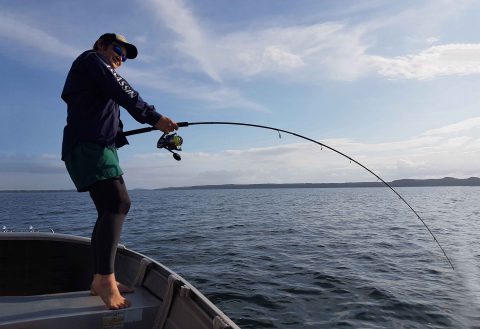Rock Surf & Deep
Conservation: Giant Kingfish
On 15 December 2015, four giant kingfish (Caranx ignobilis) that were originally caught in Durban harbour, but grew up in the Open Ocean exhibit at uShaka Sea World in Durban, were released back into the ocean near Westbrook on the KwaZulu-Natal (KZN) north coast. These four fish were juveniles when originally caught and spent between six and eight years in the aquarium before they grew too large for the exhibit.
In order to determine whether these fish survived and to track their subsequent movements, the fish were internally tagged with acoustic tags provided by the South African Institute for Aquatic Biodiversity (SAIAB) and the Acoustic Tracking Array Platform (ATAP). Acoustic tags transmit a signal made up of acoustic pulses or ‘pings’ that are detected by an acoustic receiver (listening station). Each tag has a unique code so that every time a tagged fish moves within listening range of a receiver (approximately 500m), the fish’s unique ID will be noted as well as the exact time. Acoustic receivers are placed at strategic locations along the coast so that the movement of any acoustically tagged fish can be recorded over many hundreds of kilometres.
To date, three of the four acoustically tagged kingfish have been picked up on ATAP acoustic receivers deployed along the KZN coast. The smallest fish tagged (780mm fork length) was recorded twice on a receiver located near Umdloti (just south of the release locality) on the same day – 15 December 2015 – when it was released. It was then recorded four times on one of the receivers off Jesser Point (Sodwana Bay) four days later on 19 December 2015. This is a distance of about 293km, indicating that this fish headed north at a remarkable speed of 73km per day!
The largest fish tagged and released (1 120mm fork length) was recorded 86 times on the Umdloti receiver on the same day it was released (15 December) and on 16 December 2015 between 13:28 in the afternoon and 03:01 the next morning. It then left the area for 27 days before it was recorded again back at the Umdloti receiver on 12 January 2016. This fish then moved south and was recorded five days later on 17 January 2016 on two receivers located off the Bluff (Blood Reef receivers) – a distance of 27km. It then left and was recorded back at the Umdloti receiver 30 times between 7 and 31 March 2016. The fish then headed north and was recorded 112 times on the Jesser Point receivers two weeks later on 14 April 2016, a distance of 293 km. Amazingly it continued its travels northwards and was picked up two days later on one of the receivers located off Ponta do Ouro (Mozambique) – a distance of 79km (39.5km/day).
The third fish tagged (860mm fork length) was recorded 205 times on the two Blood Reef receivers off the Bluff between 5 and 12 February 2016. It then moved away and was recorded three times on the Umdloti receiver five months later on 28 July 2016. It has not been recorded again since July 2016, but could well show up again soon!
The fourth fish that was tagged (905mm fork length) has not been recorded on the ATAP receivers to date, and it is possible that it did not survive. The take-home message from this remarkable story is that at least three out of the four kingfish released from uShaka Sea World survived and have displayed very interesting movement patterns, some of which are very similar to those of wild tagged fish.
In addition to these four fish, scientists from the Oceanographic Research Institute (ORI) and SAIAB have acoustically tagged a further 30 giant kingfish caught in the wild off the northern KZN and southern Mozambique coast. It is hoped that by tracking the movements of these iconic game fish, greater insights will be obtained regarding their movement patterns. This valuable information will ultimately assist in improving their management and conservation.






 Sign-up and receive the Business Media MAGS newsletter OR SA Mining newsletter straight to your inbox.
Sign-up and receive the Business Media MAGS newsletter OR SA Mining newsletter straight to your inbox.